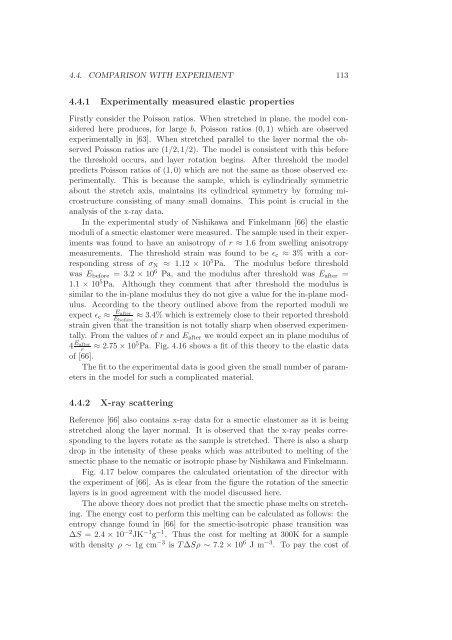Statistical models of elasticity in main chain and smectic liquid ...
Statistical models of elasticity in main chain and smectic liquid ...
Statistical models of elasticity in main chain and smectic liquid ...
Create successful ePaper yourself
Turn your PDF publications into a flip-book with our unique Google optimized e-Paper software.
4.4. COMPARISON WITH EXPERIMENT 1134.4.1 Experimentally measured elastic propertiesFirstly consider the Poisson ratios. When stretched <strong>in</strong> plane, the model consideredhere produces, for large b, Poisson ratios (0,1) which are observedexperimentally <strong>in</strong> [63]. When stretched parallel to the layer normal the observedPoisson ratios are (1/2,1/2). The model is consistent with this beforethe threshold occurs, <strong>and</strong> layer rotation beg<strong>in</strong>s. After threshold the modelpredicts Poisson ratios <strong>of</strong> (1,0) which are not the same as those observed experimentally.This is because the sample, which is cyl<strong>in</strong>drically symmetricabout the stretch axis, ma<strong>in</strong>ta<strong>in</strong>s its cyl<strong>in</strong>drical symmetry by form<strong>in</strong>g microstructureconsist<strong>in</strong>g <strong>of</strong> many small doma<strong>in</strong>s. This po<strong>in</strong>t is crucial <strong>in</strong> theanalysis <strong>of</strong> the x-ray data.In the experimental study <strong>of</strong> Nishikawa <strong>and</strong> F<strong>in</strong>kelmann [66] the elasticmoduli <strong>of</strong> a <strong>smectic</strong> elastomer were measured. Thesample used <strong>in</strong> their experimentswas found to have an anisotropy <strong>of</strong> r ≈ 1.6 from swell<strong>in</strong>g anisotropymeasurements. The threshold stra<strong>in</strong> was found to be ǫ c ≈ 3% with a correspond<strong>in</strong>gstress <strong>of</strong> σ N ≈ 1.12 × 10 5 Pa. The modulus before thresholdwas E before = 3.2 × 10 6 Pa, <strong>and</strong> the modulus after threshold was E after =1.1 × 10 5 Pa. Although they comment that after threshold the modulus issimilar to the <strong>in</strong>-plane modulus they do not give a value for the <strong>in</strong>-plane modulus.Accord<strong>in</strong>g to the theory outl<strong>in</strong>ed above from the reported moduli weexpect ǫ c ≈ E afterE before≈ 3.4% which is extremely close to their reported thresholdstra<strong>in</strong> given that the transition is not totally sharp when observed experimentally.From the values <strong>of</strong> r <strong>and</strong> E after we would expect an <strong>in</strong> plane modulus <strong>of</strong>4 E afterr≈ 2.75×10 5 Pa. Fig. 4.16 shows a fit <strong>of</strong> this theory to the elastic data<strong>of</strong> [66].The fit to the experimental data is good given the small number <strong>of</strong> parameters<strong>in</strong> the model for such a complicated material.4.4.2 X-ray scatter<strong>in</strong>gReference [66] also conta<strong>in</strong>s x-ray data for a <strong>smectic</strong> elastomer as it is be<strong>in</strong>gstretched along the layer normal. It is observed that the x-ray peaks correspond<strong>in</strong>gto the layers rotate as the sample is stretched. There is also a sharpdrop <strong>in</strong> the <strong>in</strong>tensity <strong>of</strong> these peaks which was attributed to melt<strong>in</strong>g <strong>of</strong> the<strong>smectic</strong> phaseto thenematic or isotropic phasebyNishikawa <strong>and</strong>F<strong>in</strong>kelmann.Fig. 4.17 below compares the calculated orientation <strong>of</strong> the director withthe experiment <strong>of</strong> [66]. As is clear from the figure the rotation <strong>of</strong> the <strong>smectic</strong>layers is <strong>in</strong> good agreement with the model discussed here.Theabove theory does not predictthat the <strong>smectic</strong> phasemelts on stretch<strong>in</strong>g.The energy cost to perform this melt<strong>in</strong>g can be calculated as follows: theentropy change found <strong>in</strong> [66] for the <strong>smectic</strong>-isotropic phase transition was∆S = 2.4 × 10 −2 JK −1 g −1 . Thus the cost for melt<strong>in</strong>g at 300K for a samplewith density ρ ∼ 1g cm −3 is T∆Sρ ∼ 7.2 × 10 6 J m −3 . To pay the cost <strong>of</strong>
















